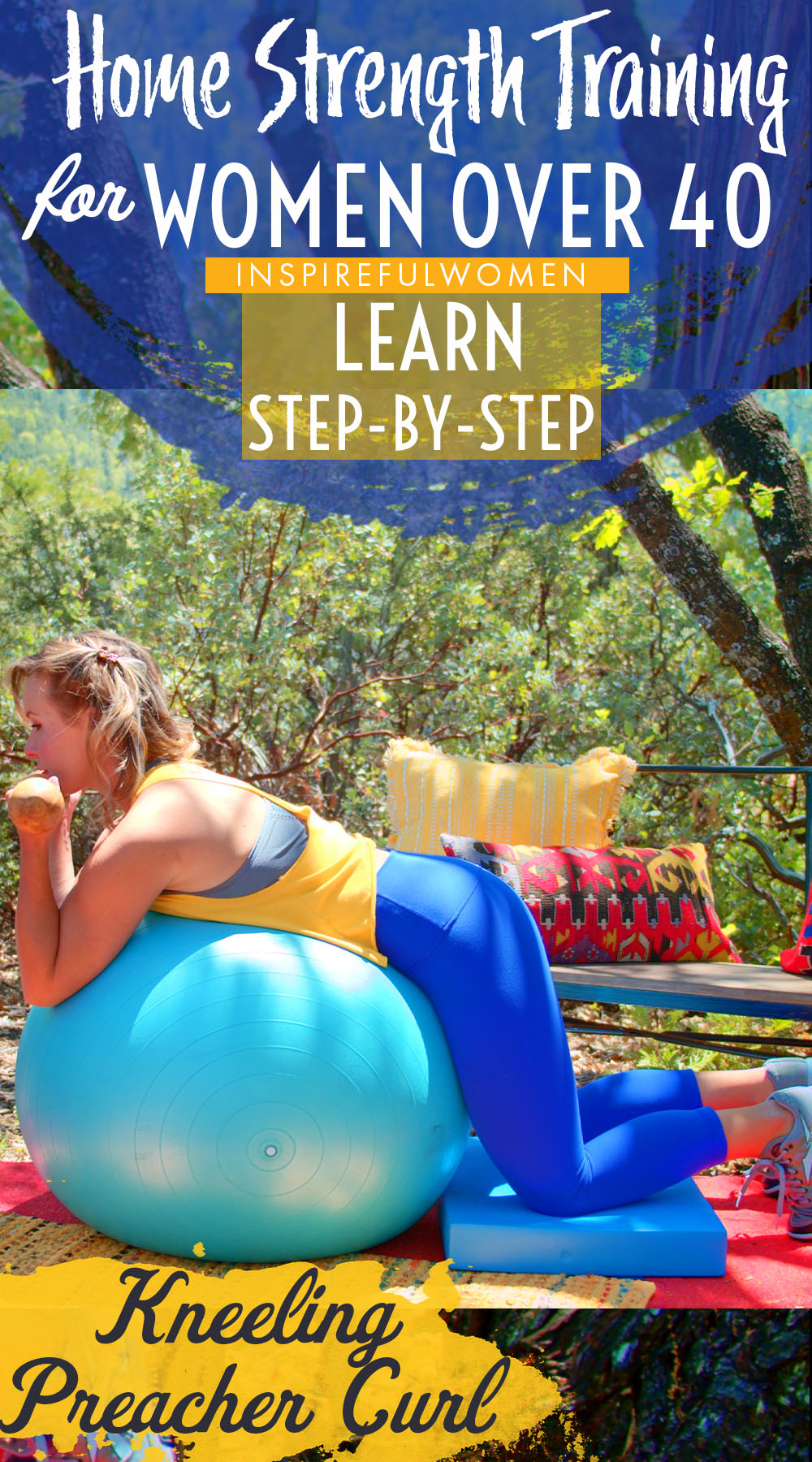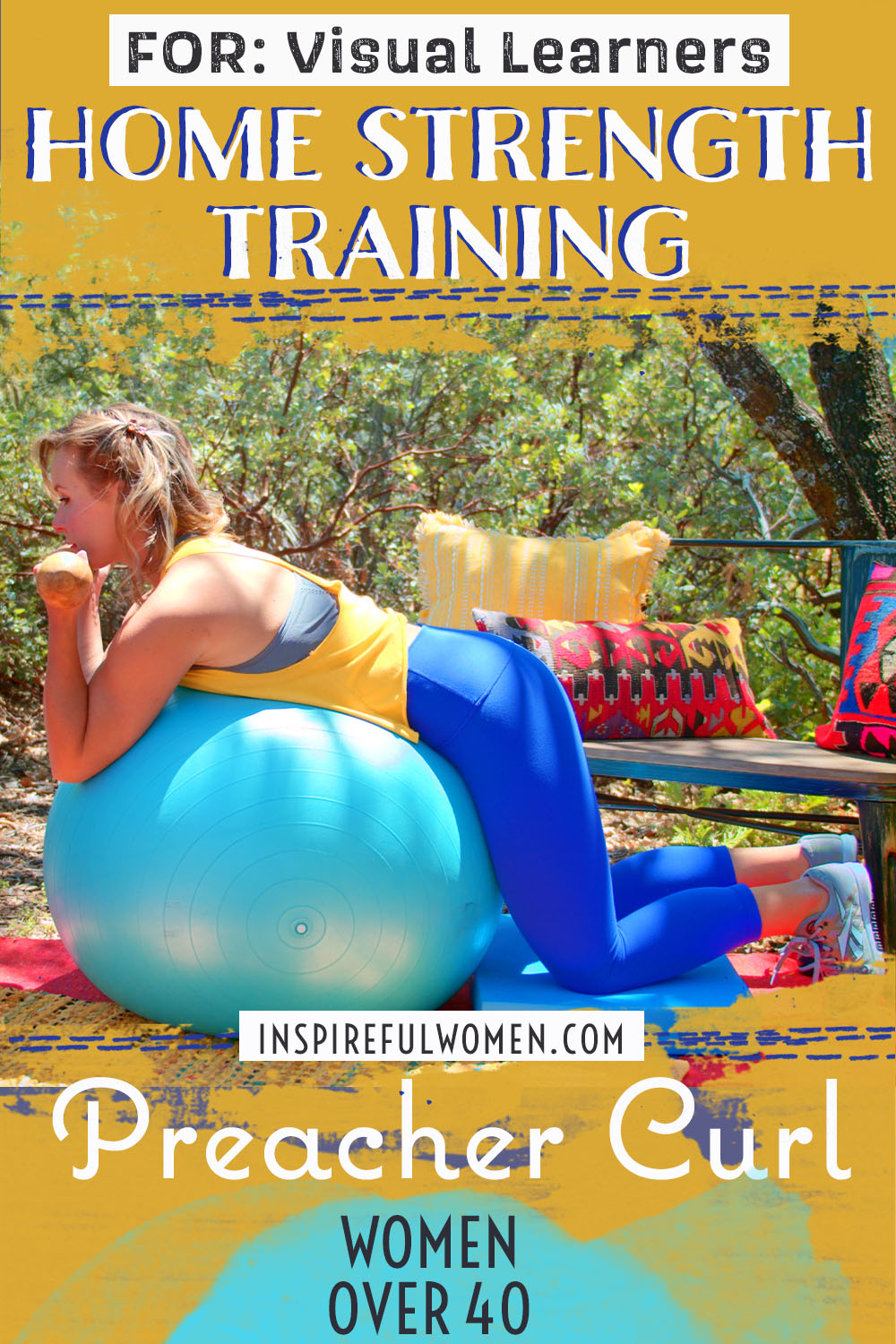Kneeling Dumbbell Preacher Bicep Curl
How to Do the Kneeling Dumbbell Preacher Bicep Curl | In-Depth Guide [VISUAL LEARNERS]
Proper Form & Common Mistakes | Home Resistance Training
WHAT DO YOU WANT TO SEE?
QUICK DEMO
QUICK DEMO
MUSCLES THIS WORKS
MUSCLES
MAIN MUSCLES WORKED IN Kneeling Dumbbell Preacher Curls
Biceps Brachii
OTHER MUSCLES WORKED:
- Brachialis
- Supinator
WHAT WE'RE DOING TODAY
WHAT & WHY
BENEFITS OF TRAINING THE biceps
WHAT
WHAT WE'RE DOING TODAY
Other names for this exercise: Scott Curl
ALL WE'RE DOING:
It's a bit awkward, but it's basically just a bicep curl alternative with your elbows laying over a stability ball.
How many ways can you adjust the basic bicep curl to make it do something slightly different? A few, a few. This is one of the weirdest ones probably. The positioning of this bicep curl is such that it lets us target the short head of the biceps a bit more- which is that more ball-shaped portion of the muscle (which we can only see if we like, workout a lot for a while) that's towards the inside of our upper arm close to our chest muscles.
Other than that, the movement is the same as far as just bending our elbows and rotating our palms to face up at the top of each rep.
WHY BOTHER DOING IT?
WHY
WHY DO WE EVEN CARE?
VARIETY FOR BICEPS
The biceps brachii (bicep means that the muscle has two heads, and brachii - meaning arm). Since the biceps is technically made up of two portions of muscle, changing up positioning and how we lift weight can target one portion more than the other and vice versa.
Both heads work to bend (flex) the elbow and rotate our forearm so the palm of our hand is up or forward (supination). To improve the strength and health of the biceps muscle it is a good idea to include exercises that will work both parts of the muscle. It is also always a good idea to add variety to your workout so that the muscles are worked in many different positions. Movements that put the arm in positions that move the short head to face forward will preferentially work the short head more than the long head.
Plus, who doesn't like to be in a slightly more "resting" type position, which we get to do with the stability ball supporting our torso & being on our knees.
EVERYDAY LIFE
EVERYDAY LIFE &
MUSCLE FUNCTION
HOW WE USE OUR biceps MUSCLES IN EVERYDAY LIFE
1. BENDING THE ELBOW (ELBOW FLEXION)
- Eating
- Lifting glass for drinking
- Dressing
- Lifting
- Carrying
- Washing/brushing hair
- Stirring
- Painting
- Brushing your teeth
- Weeding
- The list is pretty much endless...
2. TURNING YOU FOREARM UP (SUPINATION)
- Turning a door knob
- Using a screwdriver
- Turning a key
- Turning a spigot
- Receiving change
- Carrying a plate
3. LIFTING THE ARM (SHOULDER FLEXION)
- Reaching up
- Dressing
- Pushing a window up
- Washing windows
- Lifting up to the front - kids, boxes
- Carrying in front: kids, groceries, books
4. STABILIZING THE ELBOW AND SHOULDER
- Writing
- Knitting
- Reading a book
- Using a screwdriver
- Holding items in front of you - carrying a heavy box, pushing a wheelbarrow
STARTING POINTERS
Starting Pointers
The only thing I'd say about this one, is pay attention to how your shoulders feel doing this exercise. I found the positioning a bit uncomfortable in a slightly painful way for my own particular body. If that's the case for you, don't feel like you need to do this exercise.
One way to make sure you are using good form is to make sure you aren't letting your shoulders round forward- that should help a lot, and not using a super heavy weight.
HOW TO FEEL WHAT MUSCLE IS WORKING
How to Feel What Muscle is Working
Bend your elbow. Place the other hand on the upper arm with the bent elbow. Lift a heavy object with the arm - you will feel the biceps contract under your hand.
HOW TO DO THE EXERCISE
LOOKS
HOW Kneeling Dumbbell Preacher Curls SHAPE OUR BODY
Working the short head of the biceps will increase the total width of the biceps muscle.
PROPER FORM
PROPER FORM: Kneeling Dumbbell Preacher Curl
EQUIPMENT, SETS & REPS
EQUIPMENT
SUGGESTED STARTING WEIGHT FOR WOMEN:
5 - 8 pounds
SETS & REPS:
2 sets of 8 reps
PACE:
Quicker up movement (concentric) – increased power will increase the involvement of the brachioradialis. And slow lowering (eccentric).
BODY POSITION
BODY POSITION FOR THE Kneeling Dumbbell Preacher Curl
BALL - note: I find that the ball material and my bare elbows can sometimes cause a pull that is not comfortable- something that fixes that for me is to put a towel over the ball, or wear long sleeves.
KNEELING: Kneel on the floor and lean over the ball. However is comfortable. You don’t need to worry about lower body position for this one like we do for others. Knees can be wider apart if that feels more stable.
BODY STANCE: Leaning on the ball so that your upper body and arms are stabilized on the ball. The exact positioning will be dependent on the person's height, size of the ball; the goal is to have the upper arms passively positioned and stabilized in flexion and external rotation. The position should be comfortable and stable. Neutral spine position, sternum lifted, shoulder blades in and down the back.
ARMS: Shoulders are slightly forward with the pointy part of the back of your elbow resting on the ball.
Carol note re how many degrees of shoulder flexion is best: It just changes where the torque on the elbow is working the hardest - if your shoulder is at 90 degrees of flexion then when your elbow is straight the forearm is parallel to the floor - so in the beginning position - where the muscles are the weakest - there would be the most torque on the elbow, so the muscles would have to work really hard where they are the weakest. Usually what this does is limits the amount of weight you can use and only challenges the muscle for the first few inches of the movement. Then as the muscles get more capable (closer to 90 degrees of elbow flexion) the torque on the elbow decreases because the level arm is pretty much 0 in that position - the dumbbell is directly over the elbow.
The shoulder position is dependent on how far you are lying over the ball. The goal would be to have the forearm parallel to the floor when the elbow is bent between about 70 - 90 degrees. That will determine how much shoulder flexion you would have.
Rotate the upper arm so that the eye of the elbow - the soft part on the inner elbow is up - this is exactly like the way you would hold your arm when they insert the needle to draw blood - forward and rotated so the soft part is up. The elbows slightly bent in the starting position. It is important not to let the weight pull the elbows into a hyperextended position (it will strain the ligaments).
Re external rotation:
Those look really good, you are right that it is a little awkward doing both the dumbbells at the same time.
Yes when your externally rotate your upper arms, your elbows will come in a little bit -exactly what you did was perfect. I also think people will confused if you use hand position for describing shoulder rotation. That looks really good your upper arm position is good. Very good. Saying in line with the shoulder is up for a lot of interpretation. Any time that I use in line with a joint, I am always lining up the center of the joint. Most people probably don't do this, then you would have to wonder what part of the shoulder they are lining up!
But, the bottom line with this exercise is that you really want that arm in front and externally rotated. If I don't bring my elbows in slightly - exactly as you had them, I find the curve of the ball makes my arms tend to migrate out to the sides and then I need to work my shoulder muscles to hold them in front. If I bring them in nst a little bit they tend to stay put without effort. Does that help? LOL. Anyway, you did it perfectly.
So much is dependent on the size of the ball, and even the squishiness of the ball. These two different videos show some of the variation in the position based on ball and body size. It looks like you need to move up on to the ball more, or back on the ball whichever way feels more comfortable. I have done them standing also, with the ball on a chair. Also move your arms closer together. (I would say the elbow in line with the shoulder joint. The position of the hand relative to the shoulder joint will be dependent on how small or large their carrying angle is.)
Yes you are in shoulder external rotation - but I would suggest lifting the upper arm up off of the ball,eternally rotating the upper arm and setting them back down, it will feel better on the backs of your arms. It depends on the size of their ball. If they think about moving their hands apart, it might lead to them moving their upper arms out, and not be directly on top of the ball, and really well supported. You want their shoulder muscles to be as relaxed as possible so they can focus on the biceps.
The shoulder flexion is just to take that action out of the picture so that the biceps can concentrate on supination and flexion. What you want to look for is that the arm is being supported by the ball so the shoulder muscles aren't working to hold the arm up - I think that your triceps are pushing down into the ball to help stabilize and that is why you are feeling it there.
If you move up on the ball (my torso to become more on top of the ball than it was- Yes, like the one video where is basically lying over the ball with her stomach on the ball - I think her ball is too big for her to be able to lean over it and have her arm in the right position so she lies over the top,)I think you will feel the muscle working for a longer time - the position you are in the resistance is going to be greatest in the very early part of the movement - where the biceps is weaker, by the time the elbow is bent 90 degrees - where the biceps is the strongest - the weight is well past being parallel to the floor - so the resistance is less and the biceps is stronger, and then past 100 degrees of elbow flexion, the brachialis is strongest. If you move forward on the ball you can probably get close to the elbow being bent 90 degrees when the weight is parallel to the floor.
HAND/GRIP: Neutral grip - Palms facing inwards – towards each other. Hold the handle of the dumbbell closer to the end of the dumbbell that is on the thumb side of your hand - so the head on the pinky side is further away from your wrist.
Why do this: It makes the lever arm longer between the head of the dumbbell and the axis of rotation. Basically there is more weight on the inside so the forearm arm is being pulled into prontation by the weight. The biceps will need to work a little bit harder.
NECK: Neutral and relaxed.
HOW TO DO
HOW TO DO Kneeling Dumbbell Preacher Curls
CUE: Concentrate on squeezing the inside portion of your biceps.
Begin by bending your elbows to pull the dumbbells up towards your shoulder.
As you pull the dumbbells up, rotate your forearm so that your palm faces up. The head of the dumbbell on the pinky side of your hand should be leading the way, and should come close to the inside of your shoulder (where it meets the torso).
Try to complete the forearm rotation by the time your elbows are flexed 90 degrees (to maximize the resistance on the biceps and supinator muscles).
Once you have reached the end of your elbow flexion (fully bent), squeeze the inside of your biceps and pause.
Reverse the movement and slowly lower the weights back down. Keep a slight bend in the elbow to keep tension on the muscle and to prevent overstretching the ligaments of the elbow. in standing the weight is pulling down and it’s okay to let the arm fully straighten, as the joint will not bend backwards, but when the hand is up like in this position, the weight is pulling down so it can hyperextend (bend backwards) the joint and stretch the ligaments.
Begin the next rep.
HOW TO SAFELY GET OUT OF THE EXERCISE
Bend your elbows. Stand up, moving off of the ball, bend your knees and hips to squat down and set weights on the floor.
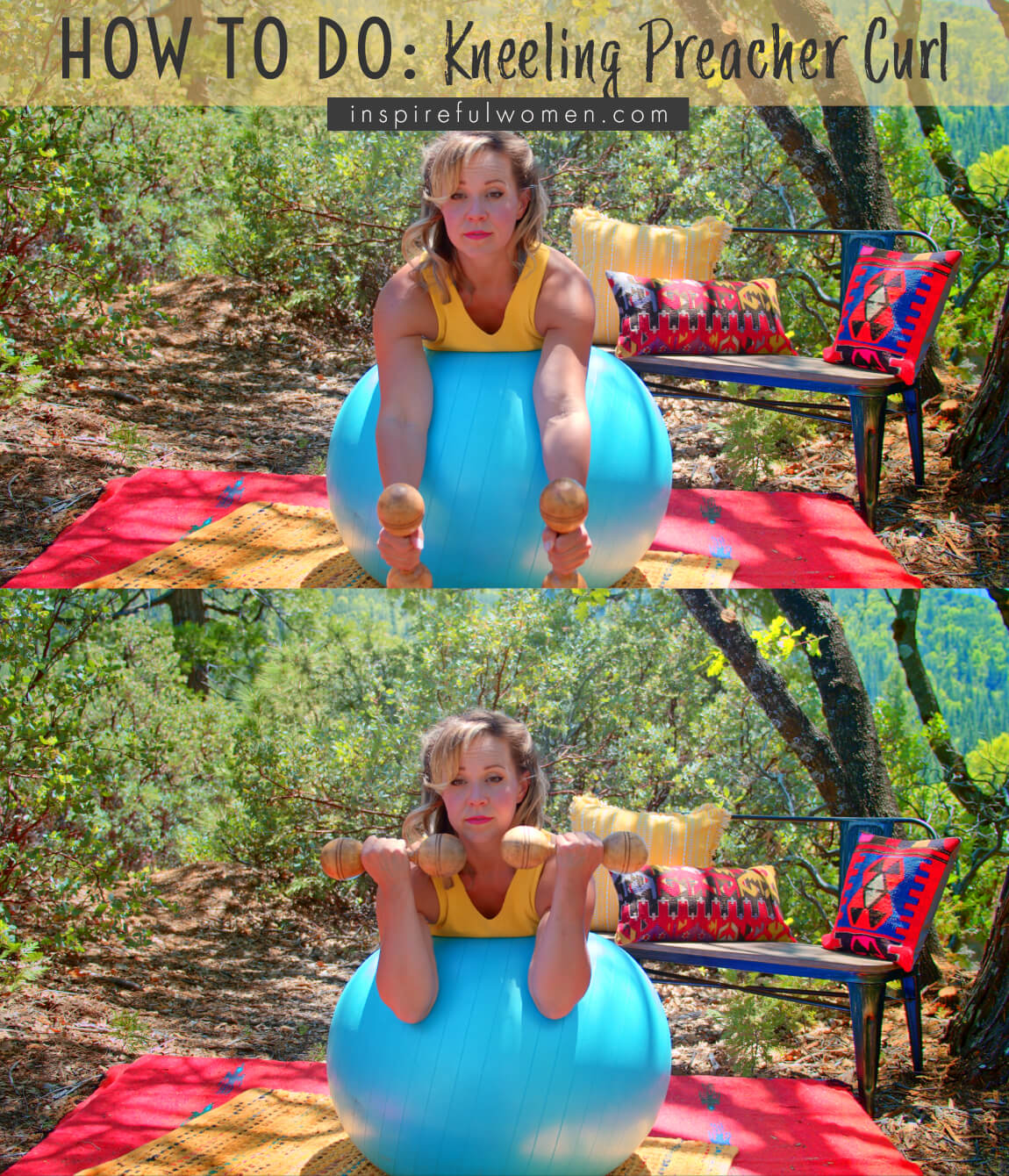
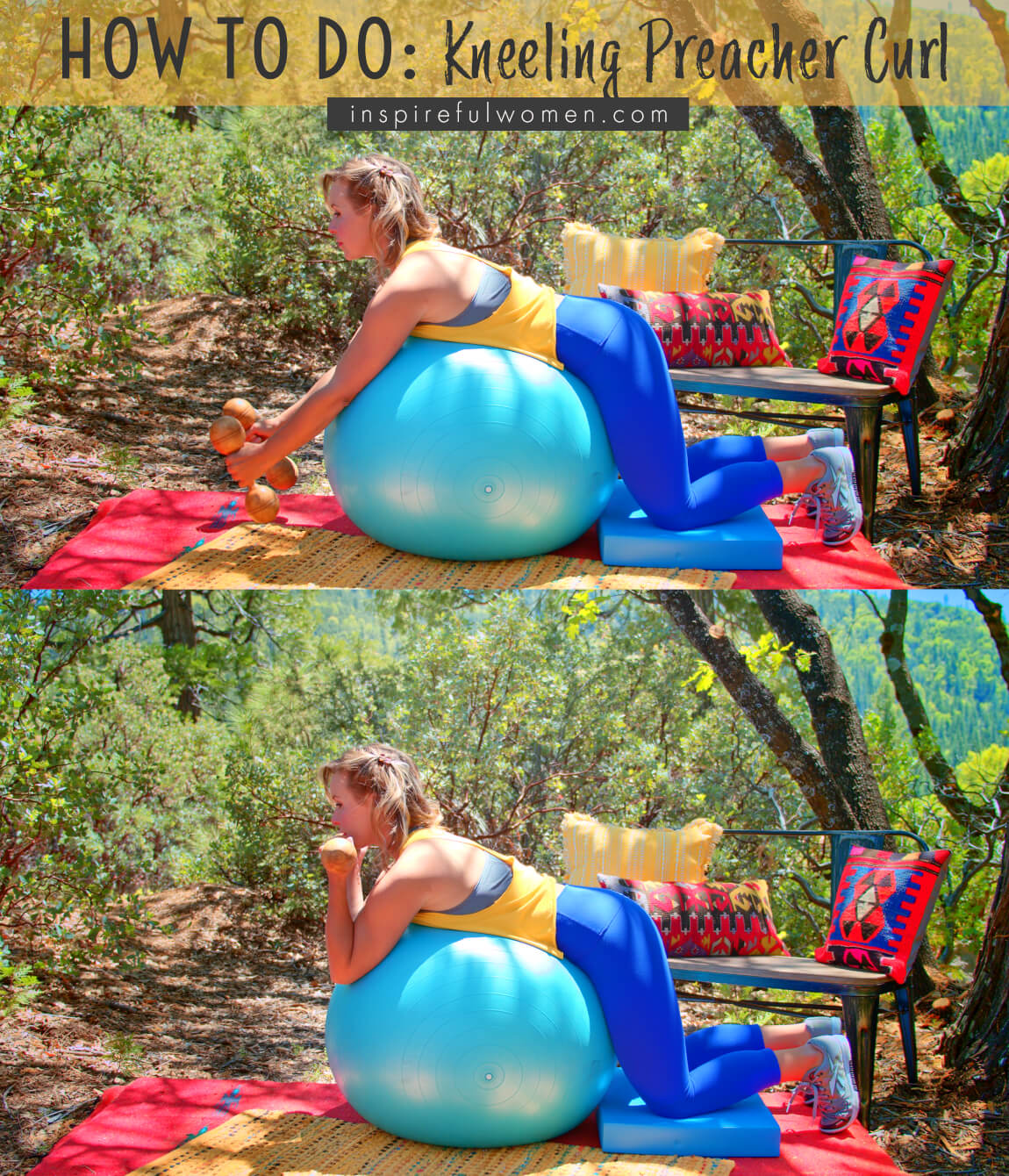
COMMON MISTAKES
COMMON MISTAKES
WHAT TO AVOID WITH THE Kneeling Dumbbell Preacher Curl
KEY TIP:
Guess what? Good news! Many avoids are the same for most movements. Once you learn the basics, there's really only a few extra avoids for each individual movement.
1. Avoid Elbows Flaring
AVOID: Letting your elbows move out to the sides
WHY NOT?
- This will change the downward pull of gravity and will increase the activity of the shoulder.
WHAT TO DO:
- The upper arm should be resting on your sides, not moving.
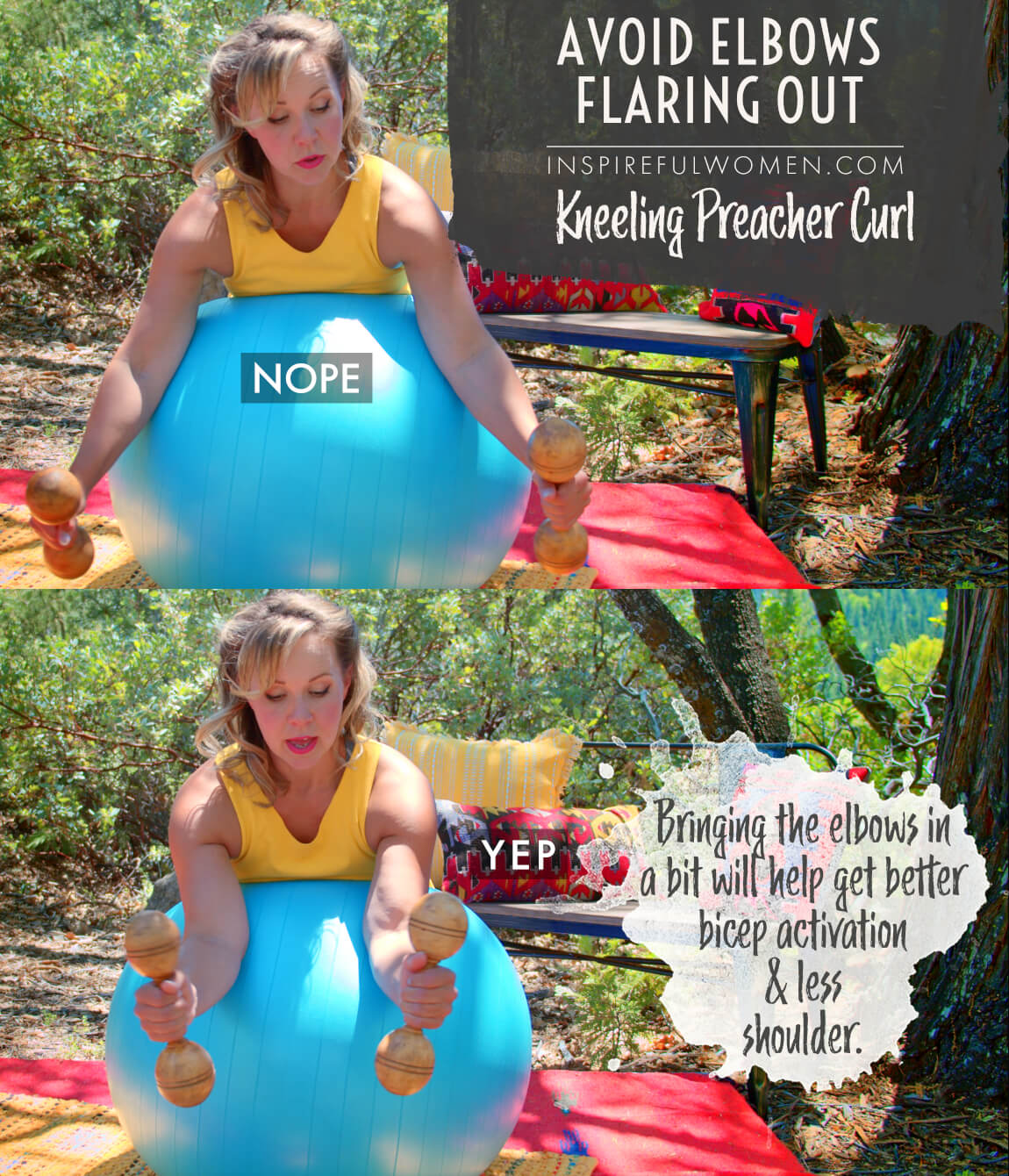
2. Avoid Rounding Shoulders
AVOID: Rounding the shoulders forward.
WHY NOT?
- This means that you are trying to use the anterior deltoid and chest muscles to help bend the elbow.
- This can decrease the space between the shoulder blade and the upper arm bone (humerus) and irritate the tissues.
WHAT TO DO:
- Pull the shoulder blades in and down the back, and lift the sternum to correct your posture.
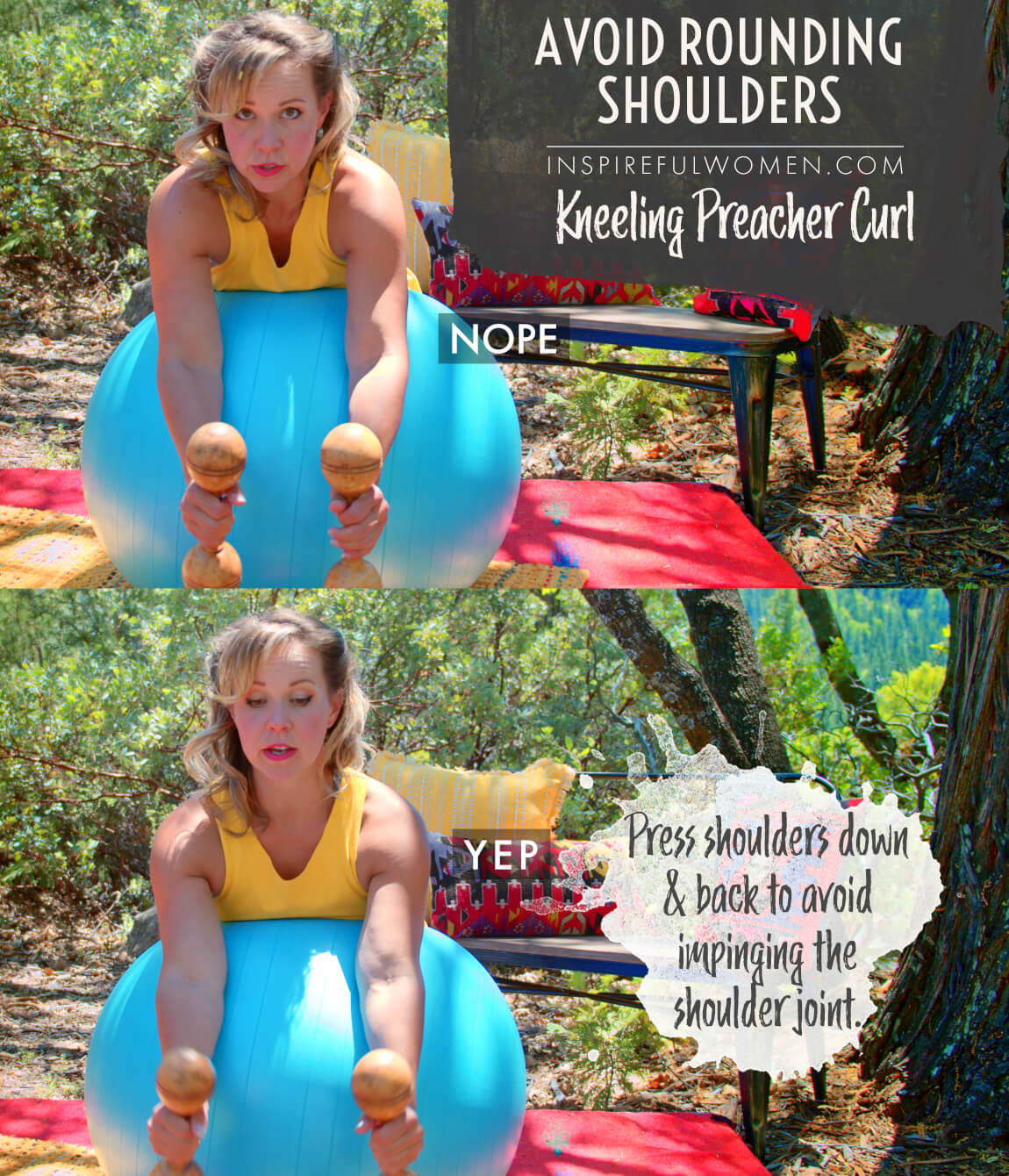
3. Avoid Hunching Shoulders
AVOID: Hunching the shoulders up towards the ears.
WHY NOT?
- This can happen when you try to use your upper trap to help the biceps
- You will note decreased space between the shoulders and earlobes.
WHAT TO DO:
- Pull the shoulders down to keep the space between the ear and the shoulder during the entire rep - this opens up the shoulder to avoid tendon irritation and decreases the activity of the upper traps.
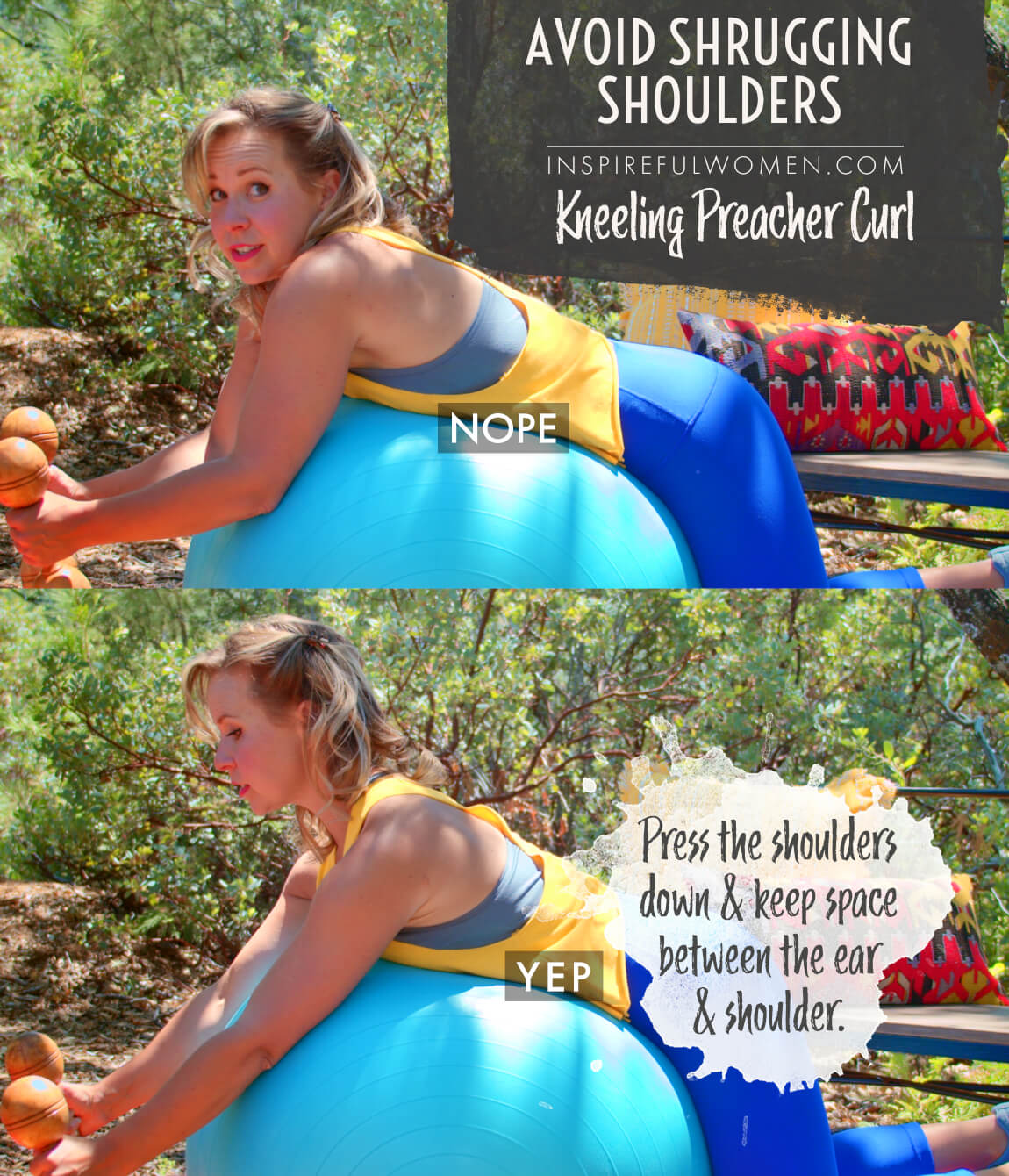
4. Avoid Shifting Weight
AVOID: Leaning back or shifting your weight.
WHY NOT:
- This will decrease the work being done by the muscles of the arms and upper back
- This is a common way the brain will try to make the exercise easier - using your body weight to help pull the hands up.
WHAT TO DO:
- Keep the shoulders over the hips, over the feet, keep your weight evenly distributed in your feet.
- Bend the knees slightly and activate your core muscles.
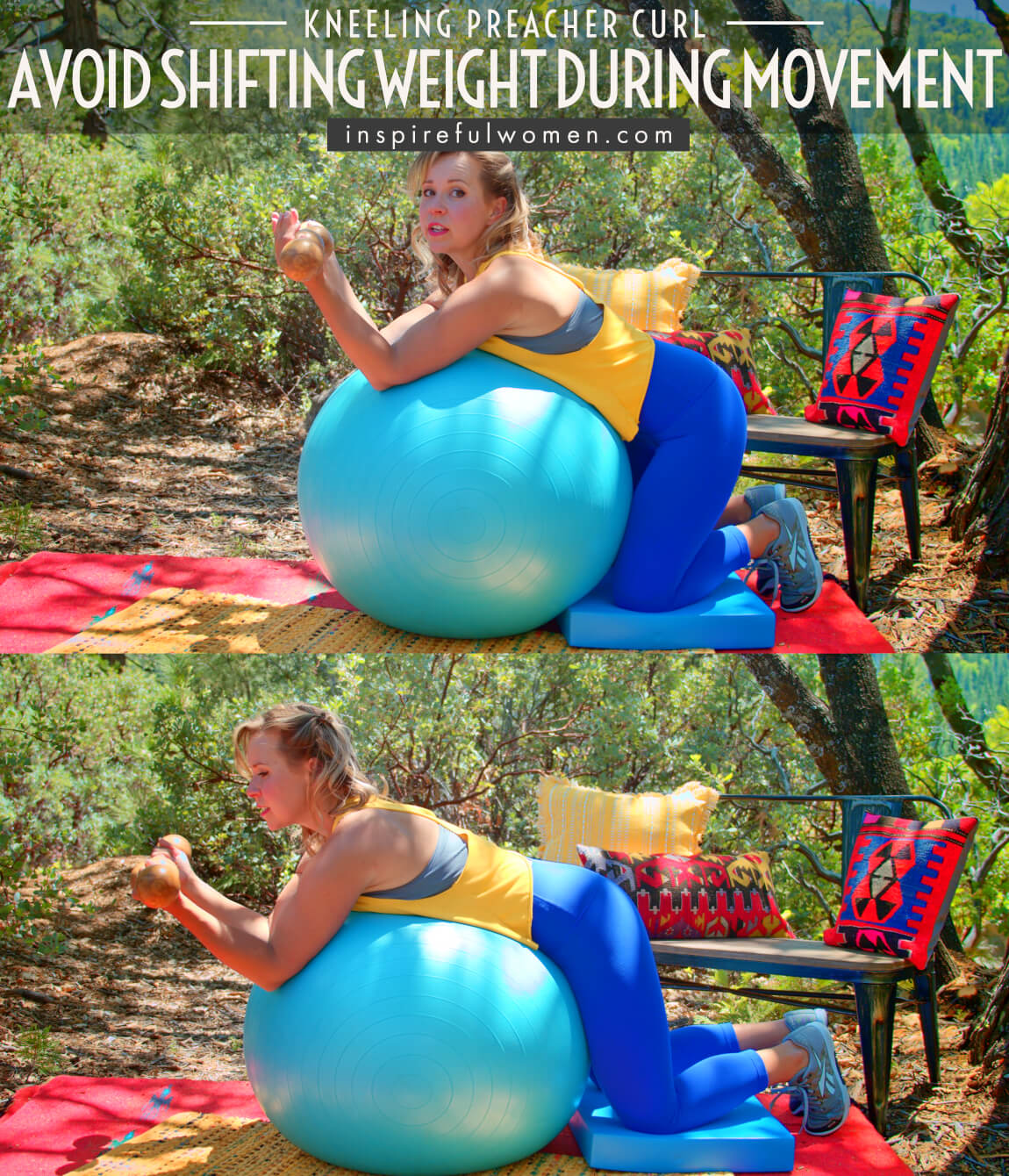
5. Avoid Bending Wrists
AVOID: Bending at your wrists.
WHY NOT?
- Poor alignment (bent forward or backward) or repetitive movement through the wrist can lead to joint and/or soft tissue irritation or injury over time.
WHAT TO DO:
- Your wrists should be in line with your forearm and should be still throughout the exercise.
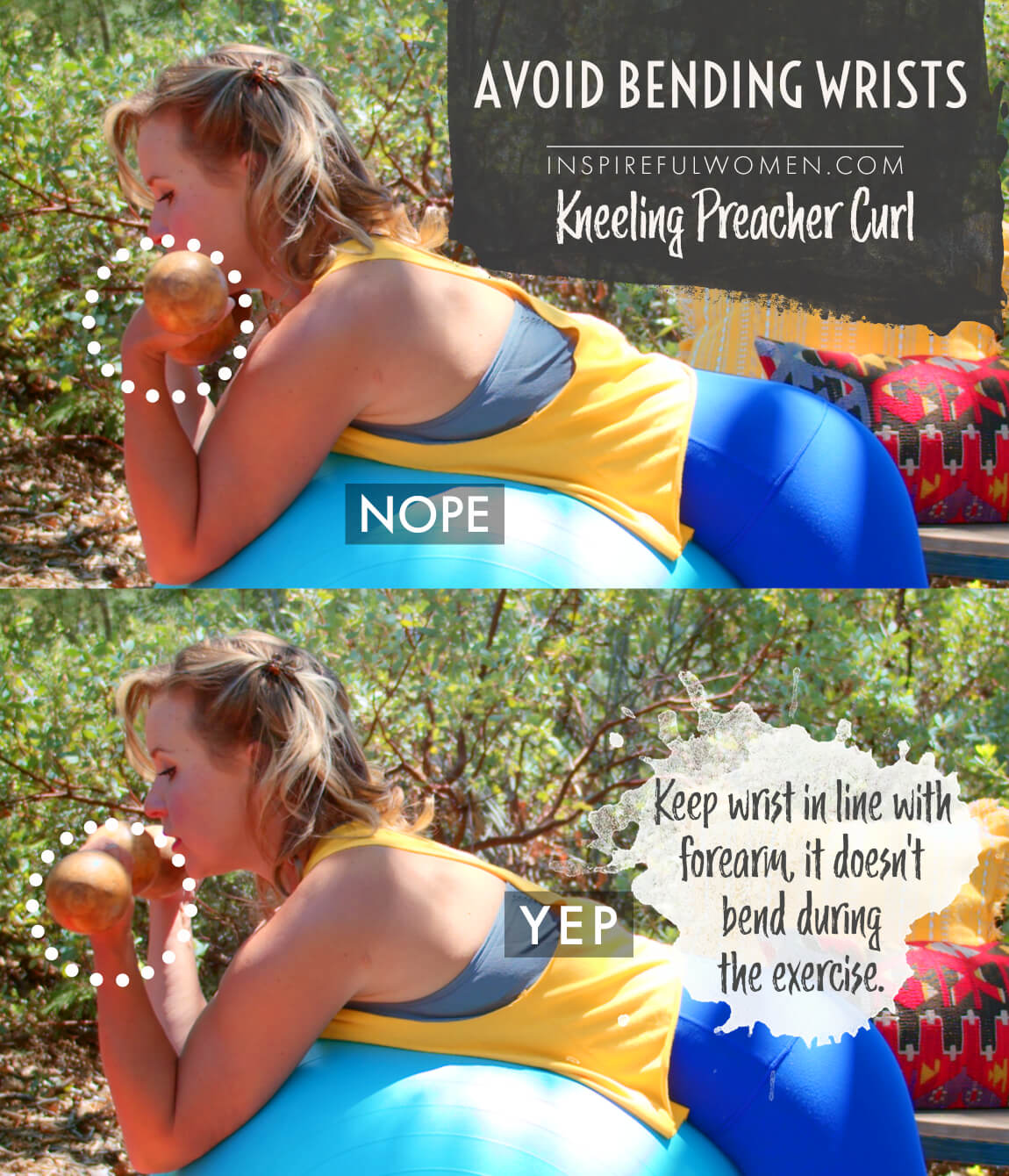
6. Avoid Bending Neck
AVOID: Bending neck.
WHY NOT?
- This can lead to neck strain, injury or damage over time.
- You may feel neck discomfort, or gripping with your neck muscles.
WHAT TO DO:
- Gripping neck muscles in an attempt to stabilize the shoulders: relax the neck and activate the core muscles more, activate the scapular stabilizers in retraction and depression.
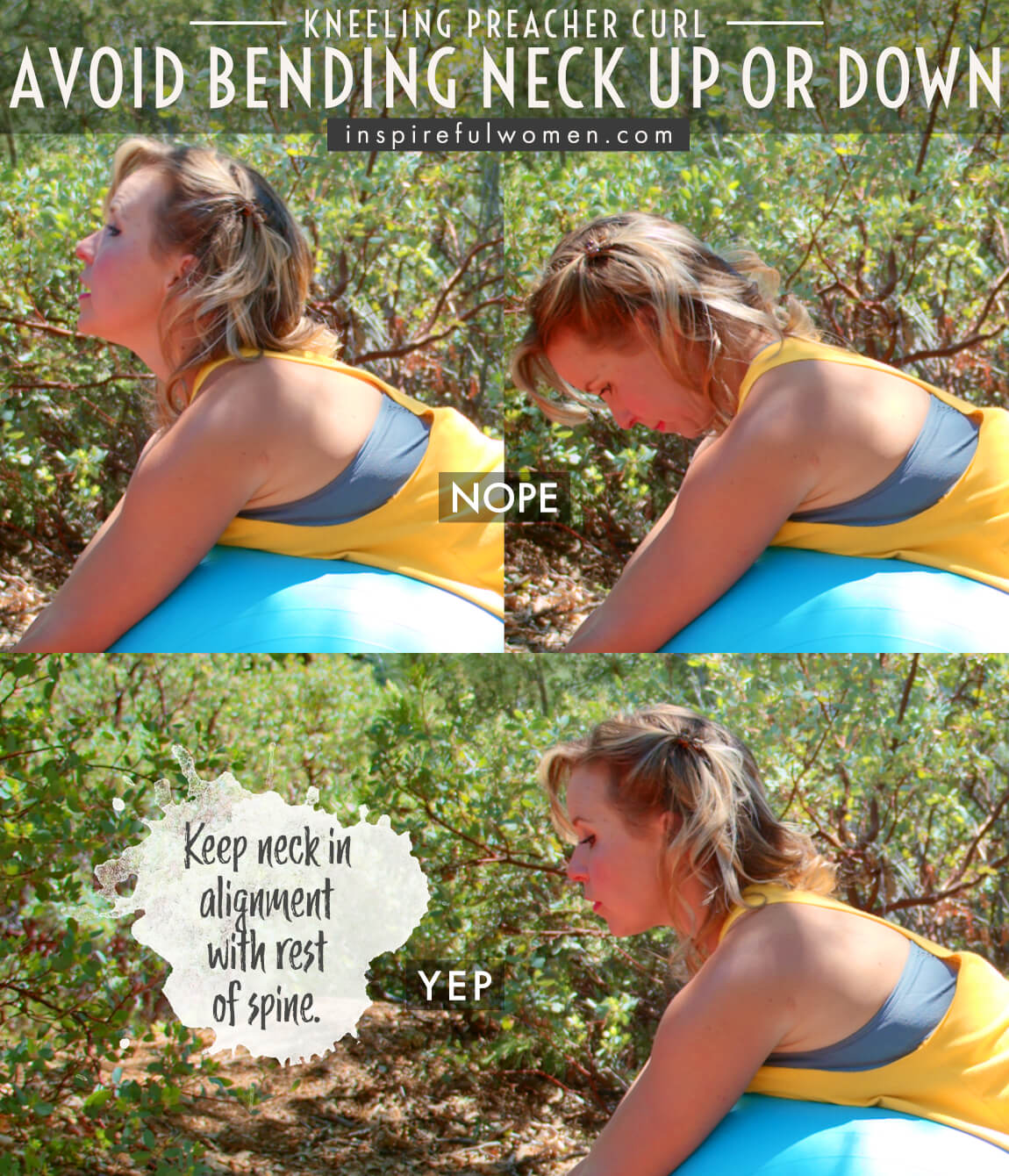
SCIENCY STUFF
SCIENCY STUFF
SPIFFILICIOUS FACTS ABOUT MUSCLES & MOVES
This exercise targets the brachialis and the short head of the biceps brachii muscle. The short head attaches to the coracoid process at the front of the shoulder blade, and lies along the inside of the upper arm. The long head of the biceps crosses the shoulder joint to attach to the “socket” portion of the shoulder joint (on the shoulder blade). Positioning the upper arm in flexion puts the long head of the biceps in a position where it is not able to contribute as much to elbow flexion. The EMG studies support this and the thought is that the long head is shortened over the shoulder, so that it is not able to produce as much force. Going back to the force-length curve - the muscle is strongest in the middle of the range - not shortened or lengthened.
Starting in this position also works the elbow flexors the hardest when they are in a stretched position. The force on the biceps is greatest when the forearm is parallel to the floor. Working the muscles in this lengthened position is thought to promote muscle growth.
Rotating the upper arm out arm is thought to bias the short head of the biceps by changing the orientation of the muscle fibers, meaning the line of pull on our muscles is more opposite the short head which means it will be in a place to do more of the work more naturally. Positioning the arm so the fibers that you want to get are directly opposite the pull of gravity.
To get more detailed - it has to do with the origin and insertion of the muscle and the lever arm of the muscle bundle itself - this is called the mechanical advantage of the muscle. So the thought is that a narrow grip biceps curl will rotate the arm so that the long head is facing forward and a wide grip will position the short head forward. A stability ball is used to stabilize the upper body and upper arms. This will decrease the need to worry about stabilizing the upper arm and shoulders, the focus can be on contracting the elbow flexors and supinators.
The long head of the biceps originates towards the top of the shoulder joint, right above where the upper arm bone forms a joint with the shoulder blade. The long head is positioned towards the outer side of the upper arm. The short head attaches to the shoulder blade towards the inside of the shoulder - right below the end of the collar bone. If you find the end of the collar bone closest to the shoulder joint, and drop your fingers down about ¼ inch you can feel the place where the short head of the biceps attaches. The short head of the biceps lies towards the inner side of the upper arm. Both of the two heads travel down the soft (hairless) part of the arm and join about mid-way down, then cross the elbow joint and insert on the forearm.
ALLLL MUSCLES & WHEN
ALL MUSCLES WORKING & WHEN DURING THE Kneeling Dumbbell Preacher Curl
The core stabilizers (obliques, transverse abdominis, quadratus lumborum, rectus abdominis, erector spinae, multifidi) work to hold the spine in a neutral position throughout the exercise. The goal of the exercise is to keep the core still as the arm moves. The scapular muscles will work to move and stabilize the shoulder blade throughout the movement - the shoulder blades will mostly stay back (retraction) and down (depression) but will move with the arm - mostly upward rotation and some protraction as the arm moves up and downward rotation and retraction as the arm comes back. The rotator cuff muscles will work to stabilize the head of the humerus (upper arm bone) in the center of the socket.
The movement begins with the upper arm flexed, adducted, and externally rotated. The arm is pulled down and across the body using the latissimus dorsi, teres major, posterior deltoid, triceps, scapular muscles to pull the shoulder blade in and down the back (retractors and depressors) and rotator cuff muscles to stabilize the shoulder joint and to move from external rotation to internal rotation (subscapularis). The muscles of the forearm hold the wrist stable and elbow (along with the upper arm muscles) still against the pull of the band.
The obliques work to hold the torso still against the rotational forces when the arm begins to pull the band down - the resistance of the band will attempt to pull the side of the torso (same side as working arm) forwards and the opposite side backwards. The obliques and transverse abdominis will also be working to draw the abdomen inwards for general spinal stabilization.
If the right arm is being used then the right side of the torso will be pulled into rotation to the left. The left external obliques and the right internal obliques would need to prevent the movement. As the arm is pulled down and across, the opposite muscle activity would be needed to prevent right rotation of the torso. This description is very simplified - the internal and external layers run in opposite directions. When they are stabilizing the core the activation of the muscles will be changing with the amount of force and the direction of force as the arm pulls down and across.
In the beginning of the movement the right quadratus lumborum will contract to prevent left side bending, but as the pulls down and across the left side will contract to prevent right side bending.
At the end of the movement, the resistance will be the greatest, most of the core muscles (multifidi, quadratus lumborum, obliques, transverse abdominis, iliopsoas, serratus posterior, lats) will be working against the rotational force to stabilize the core.
The muscles of the upper body will work eccentrically along with the same core muscles to stabilize the core and control the movement of the arm as it returns to the starting position.
PIN IT FOR LATER!
